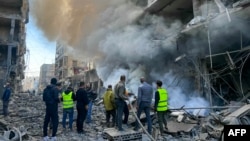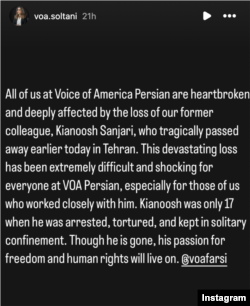
A senior Iranian official said Friday that Tehran will stand with Lebanon in “all circumstances,” as the United States and others work to secure a cease-fire deal between Israel and the Lebanese militant group Hezbollah.
The senior adviser to Iran’s supreme leader, Ali Larijani, traveled to Beirut on Friday and held talks with Lebanese caretaker Prime Minister Najib Mikati. He spoke with reporters following those talks, saying Iran “supports the people of Lebanon and its officials.”
He said Iran was not seeking to disrupt anything but to resolve issues. He called Hezbollah a “wise movement” and Lebanon, a wise nation, “but they themselves know what actions they need to take.”
Larijani said Iran hopes the situation improves “as soon as possible” and people who were forced to move from the south can return home. Iran supports Hezbollah in Lebanon and Hamas in Gaza. Both groups have been designated as terror organizations by the United States, Britain and other Western countries.
The adviser’s comments are viewed as a direct signal Iran would support a negotiated cease-fire agreement with Israel.
Larijani’s visit comes a day after Lebanese officials and media reported the U.S. ambassador to the nation, Lisa Johnson, submitted a draft of an Israel-Hezbollah peace proposal to Parliament Speaker Nabih Berri, who has been leading the talks representing Hezbollah. Larijani held a separate meeting Friday with the speaker.
The details of the proposal were not released, and the U.S. Embassy in Beirut did not confirm or deny the reports.
Continued bombardment
Despite such negotiations, Israel continues its aerial bombardment of Lebanon, with airstrikes hitting buildings in Beirut’s southern suburbs Friday, after the Israeli military issued an evacuation order in the Lebanese capital.
Video from the scene shows massive explosions and buildings crumbling in the aftermath. Major strikes hit the Dahiyeh and Tayouneh areas, among others.
In a statement posted to its X social media account, the Israel Defense Forces, or IDF, said air force fighter jets, under the direction of Israeli intelligence, launched two waves of attacks Friday as part of an effort to destroy Hezbollah targets “hidden in the heart of the civilian population” in the Dahiyeh section of Beirut.
The statement said the targets included Hezbollah munitions warehouses, headquarters and other terrorist infrastructures.
A report from the World Bank Thursday showed the cross-border fighting between Hezbollah and Israel has inflicted $8.5 billion in physical damages and economic losses to Lebanon. The report said Lebanese housing has taken the hardest hit, with nearly 100,000 housing units partially or fully destroyed, amounting to $2.8 billion in losses.
Israel invaded the Gaza Strip last year after Hamas led a terror attack on communities in southern Israel, killing about 1,200 people, according to Israeli authorities, and abducting more than 250 as hostages. About 100 of the hostages are still in Gaza, and a third of them are believed to be dead.
Since then, the Israeli counteroffensive has killed more than 43,700 people, according to Gaza health authorities. An additional 103,000 Palestinians have been injured. The Israeli military says the death toll includes thousands of Hamas militants. Israel also has destroyed much of the enclave's infrastructure, forcing most of the 2.3 million population to move several times.
The war spread to Lebanon in mid-September after months of rocket fire from Hezbollah into Israel and drone and airstrikes by Israel's military in south Lebanon escalated. More than 3,200 Lebanese have been killed, most of them in the past six weeks.
Some information in this report came from The Associated Press, Reuters and Agence France-Presse.








